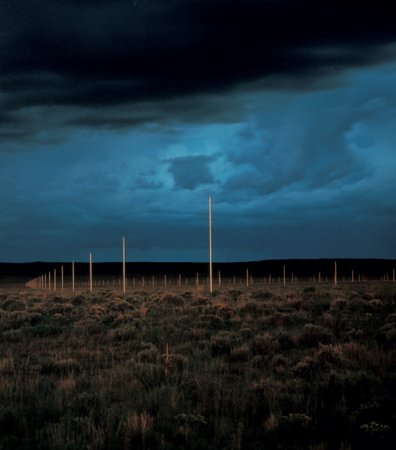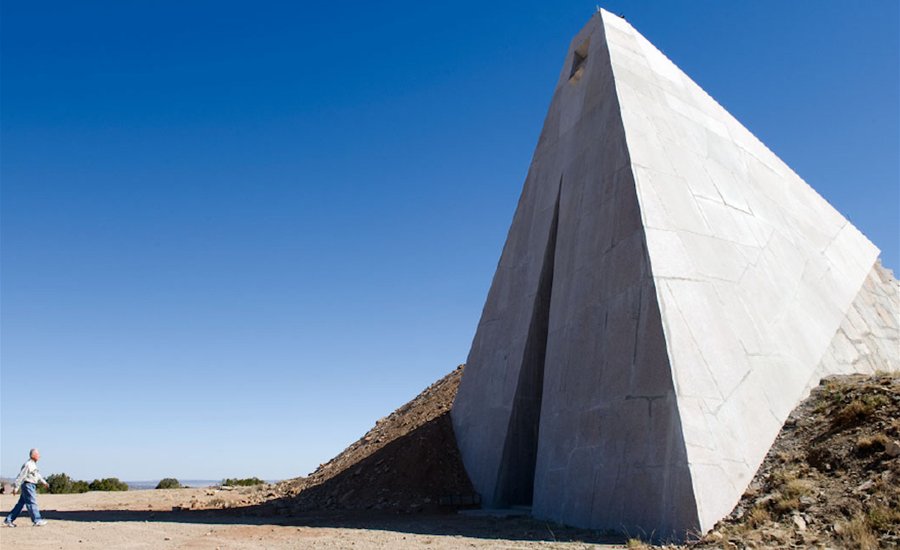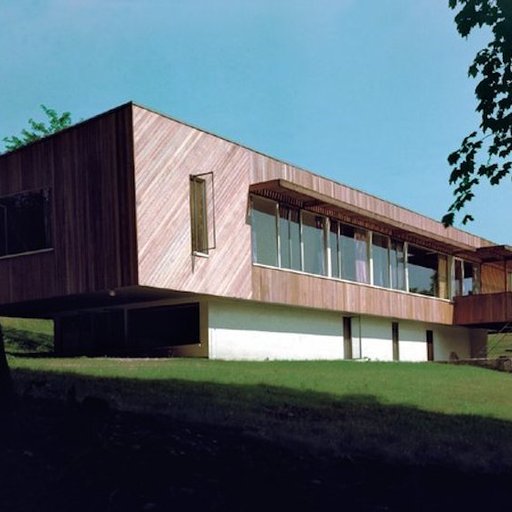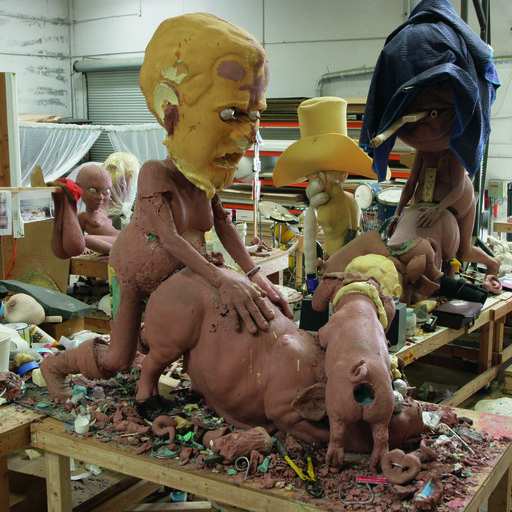For our fourth installment of our ongoing Land Art Road Trip (inspired by and excerpted from Phaidon’s Art & Place ) we travel to “The Land of Enchantment” itself—New Mexico. Featuring two of the best-known examples of environmental art by Walter De Maria and Charles Ross , the state is a must-stop-spot for earthwork enthusiasts. Happy travels!
THE LIGHTNING FIELD
Walter De Maria
Catron County, NM, USA

On a high desert plain in western New Mexico, Walter De Maria (b.1935) had 400 stainless-steel poles installed as lightning rods. Each of the polished metal poles is spaced about 67 m (220 ft) apart, and together the 16 rows of 25 poles form a grid measuring 1.6 × 1 km (1 × 0.62 miles). The poles are all 5 cm (2 in ) in diameter, but they vary in height from 4.5 to 7.9 m (14.8 to 25.9 ft) and are installed into the earth at varying depths so that their tips form a level plane regardless of the fluctuations in height of the uneven desert ground below. However, the art of this work is not to be found in the form of the grid, but in its interaction with the forces of nature.
The Dia Art Foundation , who originally commissioned the work, continues to maintain the site and provide transport and overnight accommodation for visitors with advance reservations. During the visiting season, which runs from May until the end of October, up to six people at a time can stay for one night in a wooden cabin at the site. One can never predict when lightning will strike, but when a storm does occur it is an awesome phenomenon to behold. Striking the terrain not far from the viewers’ cabin, the lightning bolts provide a sublime, fearsome, and breathtaking experience.
When a lightning storm is not raging, the site still provides visitors with a beautiful and contemplative experience. Human scale appears miniscule in this natural landscape far removed from the sights and sounds of civilization.

During the day, visitors are encouraged to walk around the field and consider the ways in which the grid maps the wild terrain. At an elevation of 2,195 m (7,201 ft) above sea level, there are no obstructions blocking the view of the vast sky. The few mountains and rock formations in the distance lie low on the horizon. One sees the open sky surrounding the desert and observes its ever changing light. At dusk and dawn in particular, the sky is ablaze with color metamorphoses; turning on the spot, the viewer can see clearly from one horizon to the other.
CHUPINAS MESA
Charles Ross
Sangre de Cristo Mountains, Anton Chico, NM, USA
 Equatorial Chamber at the foot of stairs of the Star Tunnel
Equatorial Chamber at the foot of stairs of the Star Tunnel
Trained as a mathematician and artist at the University of California, Berkeley, Charles Ross (b.1937) began his career making sculptural works out of steel and Plexiglas. In 1965 he started to produce prisms. One of the artists represented in the late 1960s by Virginia Dwan—others included Michael Heizer and Walter De Maria—Ross began in 1971 to search for a piece of land in the American southwest where he could site a large-scale environmental sculpture.
In 1976 Ross started construction on a multi-part complex, built using granite, sandstone, bronze, and stainless steel. Located atop a mesa southeast of Santa Fe, Star Axis was designed as a naked-eye observatory whose form was based on the alignments of particular stellar objects and their relationship to the human body. The Solar Pyramid marks the sun’s daily and seasonal movements across the Shadow Field. The Hour Chamber allows viewers to see one hour of the earth’s rotation, framed in a tall triangular aperture with Polaris, the north star, at its apex, while the Equatorial Chamber frames the stars seen along the earth’s equator. This chamber lies at the foot of the Star Tunnel, which rises eleven storeys from the base of an inverted cone carved into the mesa’s surface and whose oculus aligns viewers directly with the earth’s axis. The circle of sky framed by this aperture precisely represents the orbit of Polaris at a particular period in time, depending on which stair the viewer is standing on.
 A long-exposure photograph shows the path of stars across the sky; the fixed point they seem to circle is the earth’s axis of rotation projected into space
A long-exposure photograph shows the path of stars across the sky; the fixed point they seem to circle is the earth’s axis of rotation projected into space
A work in progress for almost forty years, Star Axis is a poetic reimagining of calendrical Neolithic monuments at sites such as Stonehenge. It is an example of the strand of environmental art that drew influence from originary forms of building, from structures that function not just aesthetically, but also socially or scientifically. Set in the high desert of New Mexico, it responds both to the area’s many scientific observatories—the region is popular with astronomers because of its low levels of light pollution—and to the great cliff-face dwellings at locations such as Bandelier, Gila, and Puye.
























